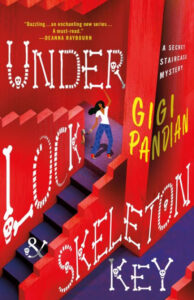John Dickson Carr (1906-1977) was one of the most prominent mystery novelists during the Golden Age of detective fiction, loosely defined as the period between the two world wars. A defining feature of the popular mysteries of this time was a fair play puzzle plot that focused onto “howdunnit” as opposed to the “whydunnit” in a whodunnit.
Psychological mysteries rose in popularity later and came to dominate mystery fiction, but in Golden Age mysteries, the puzzle was key.
I’m a huge fan of locked-room mysteries, those puzzles in which the crime appears truly impossible (locked-room mysteries are also known as “impossible crimes” or “miracle problems”). I read them widely, yet Carr continues to draw me in more than any other classic detective fiction author.
Carr is generally agreed to be the master of the locked-room mystery, but why? Many other Golden Age authors wrote clever locked-room puzzles. What elevated Carr’s novels and short stories at the time, and how has his literary magic continued to garner him new fans into the 21st century?
I’ve noticed a convergence of two elements in Carr’s fiction: he constructs truly ingenious puzzle plots and he sets the scene with a Gothic atmosphere.
A puzzle engages a reader on cerebral level, but if we’re also drawn into the story by the setting of castle ruins in the fog and hints of a ghostly, supernatural explanation, it engages us on another level. We know there’s got to be a rational explanation, but how? Along the way to find out, we’re in for a treat as over-the-top characters (like my favorite of Carr’s characters, Dr. Fell) lead us through isolated manor houses with ghostly apparitions, then emerge on the other side with an incredibly clever real-world explanation.
I wrote a more general locked-room mystery starter guide for CrimeReads in 2019, recommending many authors, books, and stories to dive into this genre.
Here, I’ve chosen several examples of John Dickson Carr’s works that combine the two elements he combined brilliantly: a wickedly clever puzzle and a Gothic atmosphere:
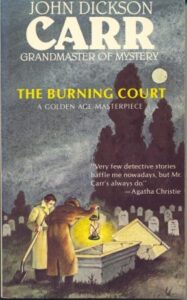
The Burning Court (1937)
A woman who’s very much alive but was supposedly put to death in the previous century for witchcraft, a crypt, and a ghost who can walk through a door that’s been bricked up for 200 years. There’s a rational explanation for everything… or is there?

Hag’s Nook (1933)
The first Dr. Gideon Fell novel, featuring a family curse and an isolated English countryside home with a view of prison ruins on “Hag’s Nook,” a site where witches were once hung—and where the family curse is about to play out once more when the eldest son is required to spent an hour inside the prison to inherit the family fortune. Dr. Fell went on to become Carr’s most well-known detective.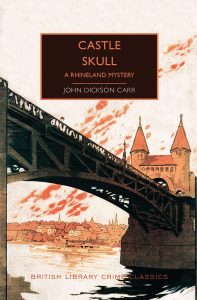
Castle Skull (1931)
The spooky Gothic setting is in the title of this mystery filled with ghosts, legends, and magic. The castle built in the shape of a skull once belonged to a famous stage magician who died under seemingly impossible circumstances, and now a new baffling death at the castle has occurred. One of Carr’s early novels that’s a bit melodramatic, but a lot of fun.
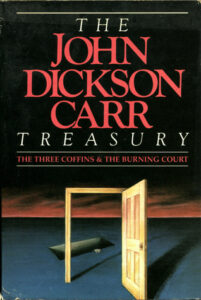
Short story “The House in Goblin Wood” (1947)
A mysterious disappearance from the past repeats itself in the present. Are the fairies in the haunted woods responsible, or is something far more sinister going on?
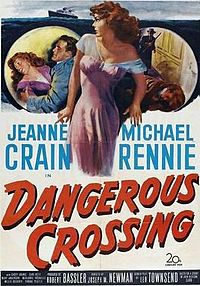
Radio play “Cabin B-13” (1943)
Adapted to cinema as Dangerous Crossing
A new bride’s husband disappears on board an ocean liner, but there’s no search overboard—because everyone on the ship insists the man never existed. The confined ship setting creates a similar feeling to an isolated manor house, and the radio broadcast (available on YouTube) used dramatic music and sounds like the fog horn to create a sense of dread.
*
With his ingenious and atmospheric tales, John Dickson Carr inspired what I think of as my Gothic Cozy voice as a writer. I love layering traditional mystery puzzle plots with quirky characters, a lighthearted tone, no on-the-page violence, and the hint of a spooky atmosphere that will trip up the characters while making readers smile.
My new novel Under Lock & Skeleton Key is a locked-room mystery with a fair-play puzzle plot—plus a family curse and possible haunting. When Tempest Raj’s stage double is found dead inside a wall that’s been sealed for a century, she must use her skills creating misdirection to see through the trick and find the rational explanation for the impossible situation.
I had a lot of fun paying homage to John Dickson Carr and other Golden Age of detective fiction authors in Under Lock & Skeleton Key. References to the greats are sprinkled throughout the novel, since one of the characters works at the Locked Room Library, a private library devoted to classic mystery novels. The Locked Room Library setting first appeared in my Edgar Award-nominated short story “The Locked Room Library” published in Ellery Queen Mystery Magazine, and it was so much fun that it had to make its way into a novel.
Now I’d better get back to work on my next locked-room mystery.
***


